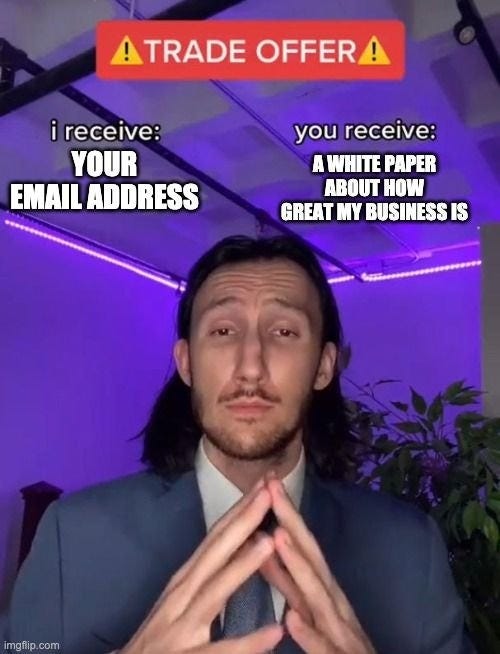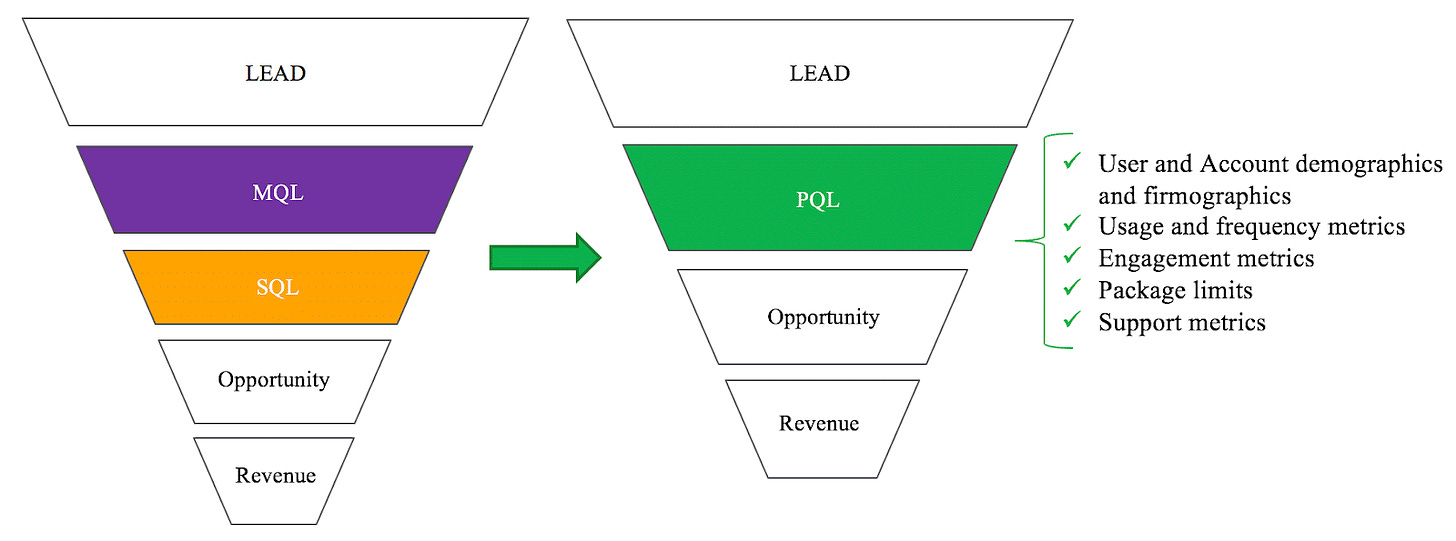The current state of B2B Marketing
My thoughts on B2B marketing today and how I think it's changing – and how we, as marketers, should adapt.
I’ve been working in B2B marketing for a few years now. It’s what I spend the majority of my working days thinking about.
Here’s my attempt at explaining why I think it’s changing, and how companies can successfully adapt to the new way of doing B2B marketing.
My thinking is based on the following 3 trends:
Buying patterns have changed in large part due to the unstoppable shift towards Product-led Growth
The advent of security & privacy in ad platforms driving up CAC
The saturation of customers towards B2B brands flooding their feeds and inboxes
I’ll dive into each of these trends in a bit. But first, let’s have a look at what I mean by “the old way of doing B2B marketing”.
The traditional B2B marketing playbook
Let’s ignore channels for a minute.
Most B2B SaaS businesses today run their marketing engine the same way it’s been done for the past 15+ years.
Here’s how it goes. You get a bunch of people to give you their email on your website (through content, ads, webinars, etc.), making them leads.
Once you have their email, they automatically get enrolled in a nurturing flow, in which a sequence of emails are sent out over a set period of time. If they show additional interest (for instance, by downloading your ebook or opening your email), they become Marketing Qualified Leads (MQLs).
Once they’re MQLs, they get added to other nurturing sequences, or get contacted by SDRs, inviting them to book a demo with a salesperson to learn more about your product. The goal here is to get these MQLs to become Sales Qualified Leads (SQLs).
From there, the ball is in your Sales team’s court. They work towards turning this SQL into a customer.
I’m oversimplifying a little, but it generally looks like this: Lead → MQL → SQL → Customer
Inherently, this is a funnel that still makes sense today. But I believe that many businesses are not fit anymore for this way of looking at B2B Marketing, for the following reasons.
Buying patterns have changed
Think of the last time you subscribed to a B2B software.
For me, it was Livestorm. I’d heard about it before, and I saw other companies I look up to using it.
I signed up on their website, and I was immediately in the product. I tested a few features and even got to launch my first webinar.
Completely for free, without speaking to anyone at Livestorm or adding my card details.
Once I figured that the product was neatly designed, didn’t have any major red flags and did the job I needed it to do, the decision was easy for me to start a subscription.
End users (like me) are now the ones trying, and subscribing to, B2B software. I believe that, for the majority of SaaS products, the era of selling to C-suite executives through demo calls is slowly coming to an end for SMBs.
Examples like these are everywhere today. Companies like Miro, Figma, Linear, Hubspot and of course Slack have all grown exponentially by making their products easy to onboard to, free to try and not gated.
What this means is that they grow by delivering real product value to their users before capturing it. This is Product-led Growth.
So what does this mean?
If we look back at the traditional B2B SaaS funnel described above, people only truly get to experience product value once they’ve jumped through a bunch of hoops and spoken to a salesperson.
In this new PLG era, which I believe we are firmly in, “MQL” and “SQL” don’t mean much. Instead, these metrics get replaced by Product Qualified Lead (PQL). This is a much more relevant metric, as product usage is a much better indicator of buying intent than downloading an ebook or even attending a product demo.
There is no one-size-fits-all for PQLs. Usually, it’s a blend of feature usage, activity and demographic/firmographic data.
The point I’m trying to make here is that how people buy B2B software is increasingly looking like how B2C subscriptions are being bought. Most companies today would be doing themselves a disservice by not providing the experience these people now expect.
CAC is going up
Ad platforms are being impacted by new security and privacy updates like Apple’s iOS 14.5.
In short, users are fed up with being tracked without their consent. As a result, device manufacturers and tech companies are increasingly building features that give users the right to decide preemptively whether an app or social network can track their online behaviour. Unsurprisingly, the majority of people are opting out of tracking.
What we see coming out of this now is the inability for ad platforms to accurately target the right people for your ads. This means that 1$ spent by advertisers today will reach fewer people interested in your product than it did before. Thus, CAC is going up.
Now, there are ways to counter this, for instance by using owned data for lookalike audiences and retargeting. But in general, it has gotten harder to get the most bang for your buck with direct response ads on paid social.
I believe that performance marketing still has its place in the B2B SaaS marketer’s “channel stack”, but its use is changing.
Whereas performance marketing was mainly used as a lead acquisition driver in the 2010s, I think that it will now more and more be used to drive brand awareness. Lead acquisition through paid social can still play a role, but fewer B2B SaaS companies’ success can solely depend on it.
Customers are tired of hearing from us
The traditional B2B marketing playbook, which hinges on getting people to give their details in exchange for a piece of content, has been overplayed. B2B companies have flooded the social feeds and inboxes of people to the point of saturation.

As I mentioned previously, I believe that there is still a place for things like paid social.
But the way in which people discover new products today is different from what it was in the early days of Facebook and LinkedIn ads.
Conversion rates on traditional lead gen and email marketing campaigns have steadily declined over time, as customers get tired of being constantly bombarded with “book a demo” messages.
Instead, today’s fastest-growing products get discovered through Dark Social – communities, WOM, groups, meetups, events, etc. Places that attribution software can’t track.
The demand for new and innovative products has never been greater – but so too has the offer. To stand out from the crowd, we need to allocate resources to Dark Social and invest in brand awareness.
How we’ll get there
Until now, I’ve described what the traditional marketing funnel and tactics have looked like for B2B SaaS companies, and why I believe that this no longer works today.
Here are some of the areas I think are worth investing in to meet the expectations of today’s consumers and win in the market.
1. Get people to try out your product, then talk to Sales
Today, most B2B optimize their marketing initiatives around getting people to talk to Sales first, and then giving them access to our product.
I believe this should be flipped – get people to try out the product and nudge them to talk to your sales team once they’ve hit a certain milestone (PQL). Deliver value before capturing value.
This, of course, depends on your Product-led Growth fit: are your target users technical? Is your product intuitive? Can it deliver value rapidly? If you answered yes to all of the above, you’re probably a good candidate for PLG.
2. Goodbye MQL & SQL; Hello PQL
I won’t dive too deep into this, as I covered it above.
The main point I want to drive here is that the clearest buying intent is product usage. Whether someone has read an eBook, downloaded a white paper or opened an email tells us very little about whether they are ready to buy or not.
But someone repeatedly using your product, inviting their colleagues onto the platform and reaching their free plan limits – that tells us a lot more about their buying intent.
In PLG, MQL and SQL don’t mean much. Instead, it’s wise to define what a PQL is for your business and optimize for this metric.
3. Focus on storytelling
Getting people to try your product and optimizing for PQLs is easier said than done. To do this, you have to actually get people to care about your company and what you’re building – you have to get people to want to try your product. In other words, you have to create demand for it.
Some B2B companies don’t need to rely on storytelling much to sell products. That might be because they have a super simple use case (e.g. expense management), their product has become a commodity (e.g. video chat), or something else of that nature.
But for a lot of companies building innovative products and creating new categories, storytelling is crucial to creating demand.
What problem are you solving? Why do you exist? Why will the world be better once every company has adopted your product?
Once people understand that, and more importantly can relate to it, it will be much easier (and natural) for them to give your product a try.


